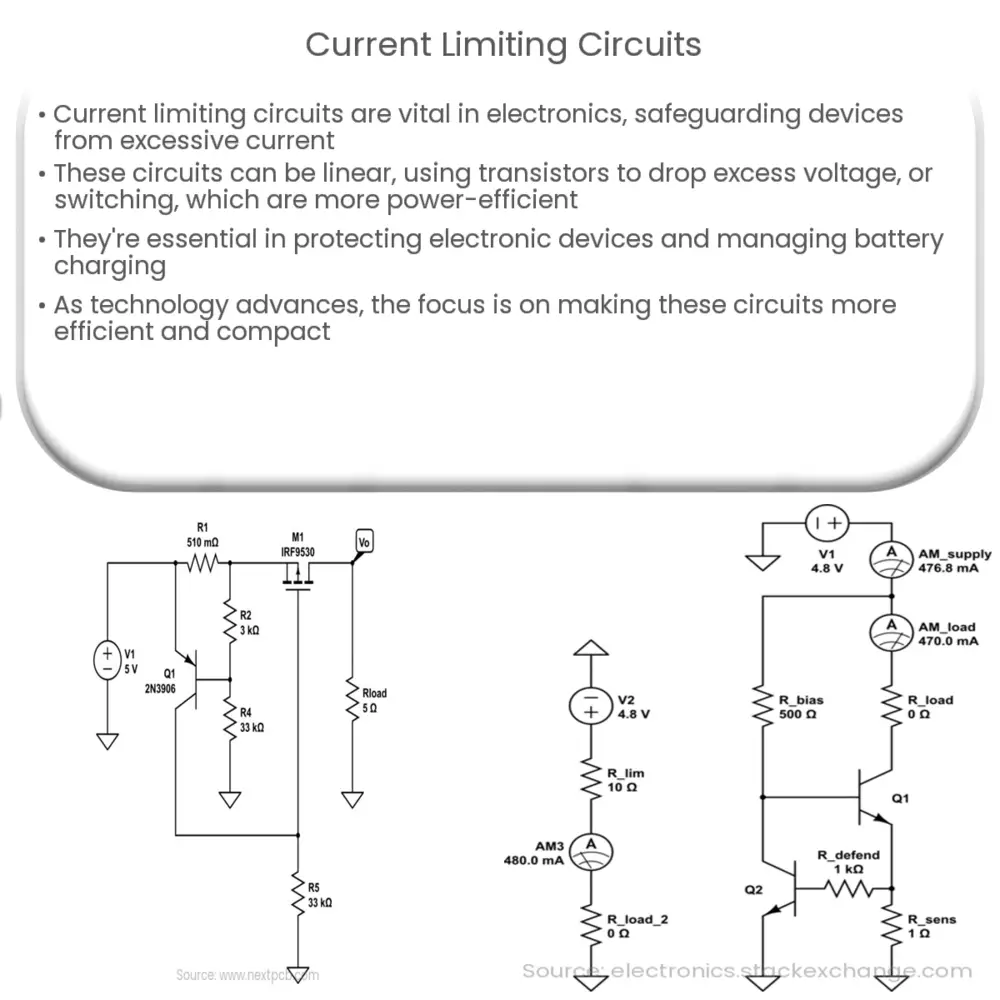Explore the role, design, types, and applications of current limiting circuits, crucial components in protecting electronic devices.

Introduction to Current Limiting Circuits
Current limiting circuits are an essential component in electronics as they protect sensitive electronic devices by preventing excessive current flow. These devices help maintain current flow at safe levels, especially in situations where there might be unexpected current surges or short circuits.
Understanding Current Limiting Circuits
A current limiting circuit is essentially a regulator designed to limit the amount of current in an electrical circuit without disrupting the functioning of the system. The prime function of this type of circuit is to prevent damage to electronic devices by controlling the electrical current flow. It’s a safeguarding mechanism that reacts swiftly in real-time when the electrical current exceeds the set limit.
Types of Current Limiting Circuits
- Linear Current Limiters: These limiters operate by using a transistor to drop the excess voltage, thus limiting the current flowing through the circuit. However, one drawback is that the transistor dissipates the dropped voltage as heat, which can potentially be an issue in power-sensitive designs.
- Switching Current Limiters: These limiters operate by rapidly switching on and off to control the voltage across the load. They’re more efficient in terms of power usage as they don’t dissipate as much heat as linear current limiters.
Applications of Current Limiting Circuits
- Protection of Electronic Devices: Many devices are susceptible to high current levels. A surge in current could potentially damage or destroy sensitive components, leading to device failure. Current limiting circuits protect these devices by ensuring the current doesn’t exceed a predefined safe level.
- Battery Charging: In charging circuits, it’s crucial to control the current flowing into the battery to prevent overcharging or damage. A current limiting circuit can be used to manage this current flow.
Current Limiting Circuit Design
At the heart of the current limiting circuit is a voltage divider network that uses a transistor as a controlling element. The transistor regulates the flow of current based on the voltage across a shunt resistor, which is in line with the load. When the current exceeds the set limit, the voltage drop across this resistor triggers the transistor into the ‘on’ state, hence limiting the current. Designing a current limiting circuit involves careful selection of the transistor and shunt resistor to match the system’s current and power specifications.
Key Components of Current Limiting Circuits
Current limiting circuits typically comprise several fundamental components, including a power source, a load, a current sensing resistor (shunt resistor), and a transistor. The circuit’s design often includes a feedback mechanism that triggers the transistor when the current exceeds the pre-set limit.
- Power Source: The power source provides the necessary energy for the circuit operation.
- Load: The load, which can be a device or a part of a circuit, utilizes the current provided by the power source.
- Shunt Resistor: Positioned in series with the load, this resistor aids in current sensing. The voltage drop across the shunt resistor is proportional to the current flowing through it. This proportional relationship allows for current monitoring.
- Transistor: This semiconductor device controls the amount of current flowing through the circuit. It acts as a switch that turns ‘on’ or ‘off’ based on the voltage across the shunt resistor.
Challenges in Designing Current Limiting Circuits
Designing an effective current limiting circuit can pose several challenges. Selecting the correct type and ratings of the transistor and shunt resistor is crucial for proper circuit operation. Moreover, thermal management needs to be addressed in designs using linear current limiters due to the heat dissipation by the transistor.
Future Trends
With the continuous advancements in technology, the demand for efficient and compact current limiting circuits is on the rise. Designers are increasingly focusing on reducing power loss and heat generation in these circuits. The trend towards miniaturization and higher power densities is also driving innovations in this field. Switching current limiters with their higher efficiency are becoming increasingly popular in applications where power efficiency is critical.
Conclusion
In conclusion, current limiting circuits play a critical role in electronics, offering a protective shield to delicate electronic components against current surges. Their strategic design involves intricate component selection and placement, and understanding the interplay of these components is fundamental to building an efficient circuit. With the relentless pursuit of increased power efficiency and miniaturization, we can anticipate further innovations in the design and application of these vital circuits. As electronics evolve, the importance of effective current limiting circuits cannot be overstated, echoing their role as crucial guardians of electronic systems.

